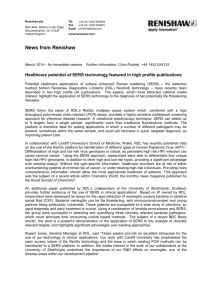Optical Properties of Gold and Drug Delivery Khan, Garbin, Stephen
advertisement
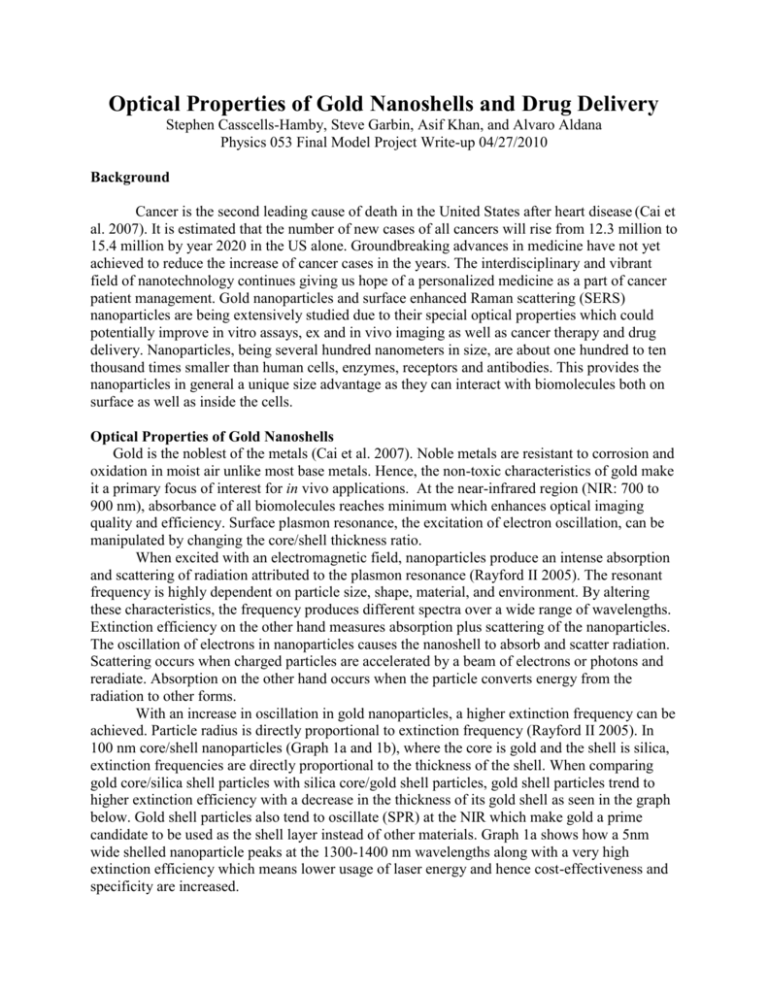
Optical Properties of Gold Nanoshells and Drug Delivery Stephen Casscells-Hamby, Steve Garbin, Asif Khan, and Alvaro Aldana Physics 053 Final Model Project Write-up 04/27/2010 Background Cancer is the second leading cause of death in the United States after heart disease (Cai et al. 2007). It is estimated that the number of new cases of all cancers will rise from 12.3 million to 15.4 million by year 2020 in the US alone. Groundbreaking advances in medicine have not yet achieved to reduce the increase of cancer cases in the years. The interdisciplinary and vibrant field of nanotechnology continues giving us hope of a personalized medicine as a part of cancer patient management. Gold nanoparticles and surface enhanced Raman scattering (SERS) nanoparticles are being extensively studied due to their special optical properties which could potentially improve in vitro assays, ex and in vivo imaging as well as cancer therapy and drug delivery. Nanoparticles, being several hundred nanometers in size, are about one hundred to ten thousand times smaller than human cells, enzymes, receptors and antibodies. This provides the nanoparticles in general a unique size advantage as they can interact with biomolecules both on surface as well as inside the cells. Optical Properties of Gold Nanoshells Gold is the noblest of the metals (Cai et al. 2007). Noble metals are resistant to corrosion and oxidation in moist air unlike most base metals. Hence, the non-toxic characteristics of gold make it a primary focus of interest for in vivo applications. At the near-infrared region (NIR: 700 to 900 nm), absorbance of all biomolecules reaches minimum which enhances optical imaging quality and efficiency. Surface plasmon resonance, the excitation of electron oscillation, can be manipulated by changing the core/shell thickness ratio. When excited with an electromagnetic field, nanoparticles produce an intense absorption and scattering of radiation attributed to the plasmon resonance (Rayford II 2005). The resonant frequency is highly dependent on particle size, shape, material, and environment. By altering these characteristics, the frequency produces different spectra over a wide range of wavelengths. Extinction efficiency on the other hand measures absorption plus scattering of the nanoparticles. The oscillation of electrons in nanoparticles causes the nanoshell to absorb and scatter radiation. Scattering occurs when charged particles are accelerated by a beam of electrons or photons and reradiate. Absorption on the other hand occurs when the particle converts energy from the radiation to other forms. With an increase in oscillation in gold nanoparticles, a higher extinction frequency can be achieved. Particle radius is directly proportional to extinction frequency (Rayford II 2005). In 100 nm core/shell nanoparticles (Graph 1a and 1b), where the core is gold and the shell is silica, extinction frequencies are directly proportional to the thickness of the shell. When comparing gold core/silica shell particles with silica core/gold shell particles, gold shell particles trend to higher extinction efficiency with a decrease in the thickness of its gold shell as seen in the graph below. Gold shell particles also tend to oscillate (SPR) at the NIR which make gold a prime candidate to be used as the shell layer instead of other materials. Graph 1a shows how a 5nm wide shelled nanoparticle peaks at the 1300-1400 nm wavelengths along with a very high extinction efficiency which means lower usage of laser energy and hence cost-effectiveness and specificity are increased. Graph 1a Silica Core/ Gold Shell Graph 1b Gold Core/ Silica Shell Surface-enhanced Raman spectroscopy (SERS) Surface-enhanced Raman spectroscopy was discovered almost 30 years ago, and even to this day, scientists are learning of this fascinating technique’s capability. Surface-enhanced Raman spectroscopy provides a lot of information about the molecule. For example, SERS can show the molecular identity, information about structural changes, the intermolecular interactions, as well as the dynamics (Huser, Thomas. 2010). SERS is a relatively old concept, but it has been adapted to invigorate the nanotechnological field. The main concept of SERS is the idea of exciting surface plasmon resonance of, in this case, gold nanoshell surface. When a nanoparticle’s surface is “bombarded” with electromagnetic waves, the nanoparticle begins to resonate, allowing scientists to use SERS to calculate the Raman signals. A sound analogy is a bathtub. If one moves the bathtub at the right frequency, then the water in the bathtub will reverberate in a synchronized rhythm, getting the water moving (see Figure 1A). Figure B shows the magnitude of the particle’s resonant frequency when being hit by its desired electromagnetic wave frequency (Stiles, Paul L. 2010) In order to observe the surface-enhanced Raman spectroscopy results accurately, the particle’s surface must be coated with specific metals, for example gold, silver, and copper (Huser, Thomas. 2010). A characteristic that reflects that of a nanoparticle’s optical properties: SERS is wavelength specific, as seen by the graphs. The reason that SERS has been joined with nanoparticles is because of not only its specificity, but also its biological applications. Unlike fluorescence, SERS does not need to label and photobleach, because the analytes SERS uses do not photobleach the designated particle (El-Sayed, Ivan H. 2010). This non-destructive, noninvasive technique is why after 30 years SERS is still in use. Epidermal Growth Factor Receptor In order to use gold nanoparticles in targeted drug therapy for cancer treatment, scientists take advantage of the over expression of epidermal growth factor receptor (EGFR) protein on the surface of cells which is associated with many types of cancer. Different cancers often lead to a mutation causing the over expression of slightly mutated EGFR protein. EGFR antibodies are created for these slightly mutated EGFR proteins and then placed on the surface of the gold nanoparticles. The EGFR antibodies then attach to cells with the over expressed EGFR protein and the drug contained within the nanoparticle through the process of photothermal ablation. Figure 2 An EGFR antibody Figure 3 Epidermal Growth Factor Receptor Protein Generally, there are two steps in photothermal ablation. The receptor on the gold nanoparticle must attach to the cancerous cell. The anti-EGFR antibodies help detect the cancerous cells. In one experiment, scientist Ivan H. El-Sayed wanted to see the result after three types of cells, two of which are malignant, are incubated with anti-EGFR antibodies conjugated with gold nanoparticles. The figure below shows the results. According to the results, anti-EGFR antibodies conjugated with gold nanoparticles connect and detect cancerous regions. Next, Marites P. Melancon in his article about gold nanoshells and photothermal ablation, he found that by using plasmonic gold nanoparticles, once can reduce the laser energy necessary for, “selective tumor cell destruction (Melancon, Marites P. 2008).” In conclusion, the use of EGFR and gold nanoshells can help make cancer diagnosis and treatment more accurate and precise. Figure 3. Benign cells (left), HSC malignant cells (middle), HOC malignant cells (right) Our MODEL We focused on modeling a gold nanoparticle specifically to highlight its optical properties. Moreover, we also modeled an epidermal growth factor as shown below. In terms of scale, the gold nanoparticles were 100 nanometers in diameter while the EGFR Proteins were in the 20 micrometer range. Gold Nanoshells Figures 4 and 5: Core/Shell Nanoparticles To construct a model of a nanoshell, we used a Styrofoam ball and made a cross section and sketched the core-layer properties as described previously. Figure 4 represents a silica layered nanoshell while Figure 5 represents a gold-layered shell. Through class demonstration, it will be shown how gold layered nanoshell has a higher extinction efficiency (using a laser we will reflect light and gold layered nanoshell will require higher intensity of laser light to reach its core) Since our primary focus of the project was to analyze the optical properties, we focused solely on the core-silica layer concept in our model through class demonstration. In the process, we did not include the surface details of gold nanoparticles. EGFR Proteins To construct our EGFR protein model we used varying sizes and colors of pipe cleaners which we connected by twisting them together and then bent into the shape of the protein. Different groups were color coded, and thicker pipe cleaners were used to indicate the locations of alpha helices and beta pleated sheets in the protein. We mapped out the basic shape of the protein using information from the Protein Database. Figure 6: Model of the EGFR Proteins References Cai W, Gao T, Hong H, and Sun J. “Applications of gold nanoparticles in cancer ….nanotechnology.” Nanotechnology, Science and Apllicatoins 2008: I 17-32. 2008. Printed. El-Sayed, Ivan H. "ScienceDirect - Cancer Letters : Selective Laser Photo ….thermal Therapy of Epithelial Carcinoma Using Anti-EGFR Antibody Conjugated Gold ….Nanoparticles." ScienceDirect - Home. 28 July 2006. Web. 22 Apr. 2010. ….http://www.sciencedirect.com/science?_ob=ArticleURL&_udi=B6T54-4H6PKX0-1&_user Epidermal Growth Factor Model. Protein Data Bank. ….http://www.rcsb.org/pdb/explore/jmol.do?structureId=1NQL&bionumber=1 Huser, Thomas. "Introduction to Surface-enhanced Raman Spectroscopy.” … Biophysics and Biomedical Engineering Graduate Groups. University of California at … ….Davis, Davis. 16 Apr. 2010. Lecture. Jain, Prashant K., Kyeong S. Lee, and Ivan H. El-Sayed. "Calculated Absorption and Scattering …Properties of Gold Nanoparticles of Different Size, Shape, and Composition: Applications …in Biological Imaging and Biomedicine." 8 Dec. 2005. Web. 15 Apr. 2010. …<http://pubs.acs.org/doi/pdf/10.1021/jp057170o>. Melancon, Marites P. Molecular Cancer Therapeutics. June 2008. Web. 22 Apr. 2010. ….<http://mct.aacrjournals.org/content/7/6/1730.full.pdf+html>. Rayford II, Cleveland Eugene. "Optical Properties of Gold Nanospheres." Nanoscape. 2.1 ….(2005): 27-33. Print. Stiles, Paul L. "Surface-Enhanced Raman Spectroscopy Review." 18 Mar. 2008. Web. …..22 Apr. 2010. …..<http://arjournals.annualreviews.org/doi/pdf/10.1146/annurev.anchem.1.031207.112814>




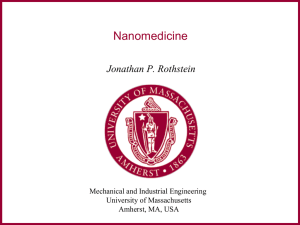
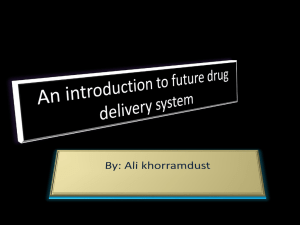
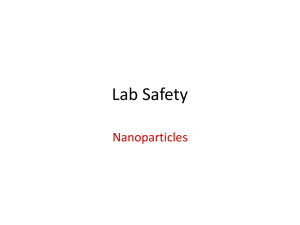
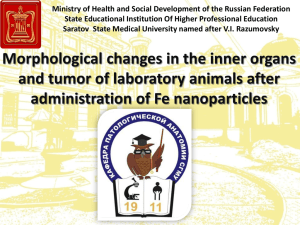
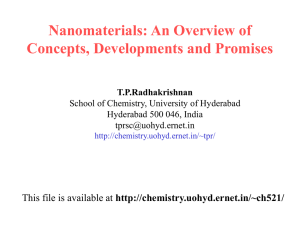
![[1] M. Fleischmann, P.J. Hendra, A.J. McQuillan, Chem. Phy. Lett. 26](http://s3.studylib.net/store/data/005884231_1-c0a3447ecba2eee2a6ded029e33997e8-300x300.png)
